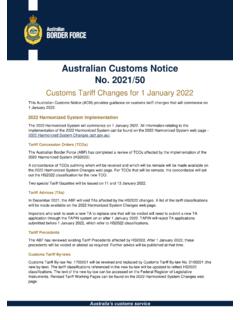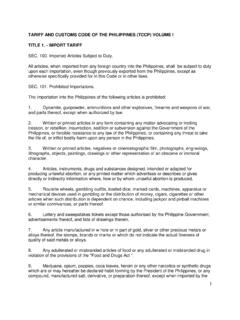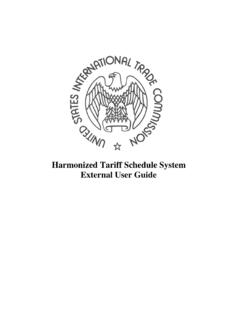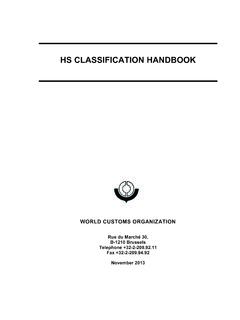Transcription of (for office use only) Customs Tariff 2020 2021
1 ((ffoorr ooffffiiccee uussee oonnllyy)) CCuussttoommss TTaarriiffff 2020/2021 (Based on harmonized System 2017 Version) GGoovveerrnnmmeenntt ooff NNeeppaall MMiinniissttrryy ooff FFiinnaannccee DDeeppaarrttmmeenntt ooff CCuussttoommss Tripureshwor, Kathmandu : 01-4117217 email: or website: Foreword Nepal has already incorporated sixth version of harmonized Commodity Description and Coding System since May 2017, as approved by the World Customs Organization. This " Customs Tariff 2020/21" has been published for official use, incorporating changes/revisions in Customs rate and other related provisions to be applied in the exportation and importation of goods for the Fiscal Year 2020/21.
2 Commodity Classification is one of the most important functions of the Customs Administration. The proper classification of commodities contributes to accurate revenue collection and also provides reliable and accurate statistics to be used in national and international trade facilitation. I believe this book will contribute to facilitate the functions mentioned above. This book contains Schedule 1, 2 & 3 of the Financial Act, 2020 laying out Customs duty rate & Road Construction Fee for goods to be imported into Nepal and Customs duty rate for goods to be exported from Nepal. The unit of measurement of goods under each sub-heading, as approved by Department of Customs on 15 July, 2020, has also been incorporated in the book in accordance with the provision of Section 22 (12) of Schedule-1 of the Financial Act, 2020.
3 This book has been published for official use, therefore, claims & legal action cannot be lodged on the basis of the provisions stipulated in the book. Utmost care has been taken to avoid errors and omissions in the book. However, in case of errors and omissions due to human error, provisions laid out by Financial Act, 2020 shall be applicable. Any constructive suggestions regarding further amendments and improvements needed are highly appreciable. I would like to thank the staffs of Policy & Tariff Section and the Classification & Review Section of the Department of Customs for their round the clock effort to give the book its shape. August, 2020 (Suman Dahal) Director General i GENERAL RULES FOR THE INTERPRETATION OF THE harmonized SYSTEM Classification of goods in the Nomenclature shall be governed by the following principles: 1.
4 The titles of Sections, Chapters and Sub-chapters are provided for ease of reference only; for legal purposes, classification shall be determined according to the terms of the headings and any relative Section or Chapter Notes and, provided such headings or Notes do not otherwise require, according to the following provisions: 2. (a) Any reference in a heading to an article shall be taken to include a reference to that article incomplete or unfinished, provided that, as presented, the incomplete or unfinished article has the essential character of the complete or finished article. It shall also be taken to include a reference to that article complete or finished (or falling to be classified as complete or finished by virtue of this Rule), presented unassembled or disassembled.
5 (b) Any reference in a heading to a material or substance shall be taken to include a reference to mixtures or combinations of that material or substance with other materials or substances. Any reference to goods of a given material or substance shall be taken to include a reference to goods consisting wholly or partly of such material or substance. The classification of goods consisting of more than one material or substance shall be according to the principles of Rule 3. 3. When by application of Rule 2(b) or for any other reason, goods are, prima facie, classifiable under two or more headings, classification shall be effected as follows: (a) The heading which provides the most specific description shall be preferred to headings providing a more general description.
6 However, when two or more headings each refer to part only of the materials or substances contained in mixed or composite goods or to part only of the items in a set put up for retail sale, those headings are to be regarded as equally specific in relation to those goods, even if one of them gives a more complete or precise description of the goods. (b) Mixtures, composite goods consisting of different materials or made up of different components,and goods put up in sets for retail sale, which cannot be classified by reference to 3(a), shall be classified ii as if they consisted of the material or component which gives them their essential character, insofar as this criterion is applicable.
7 (c) When goods cannot be classified by reference to 3(a) or 3(b), they shall be classified under the heading which occurs last in numerical order among those which equally merit consideration. 4. Goods which cannot be classified in accordance with the above Rules shall be classified under the heading appropriate to the goods to which they are most akin. 5. In addition to the foregoing provisions, the following Rules shall apply in respect of the goods referred to therein: (a) Camera cases, musical instrument cases, gun cases, drawing instrument cases, necklace cases and similar containers, specially shaped or fitted to contain a specific article or set of articles, suitable for long-term use and presented with the articles for which they are intended, shall be classified with such articles when of a kind normally sold therewith.
8 This Rule does not, however, apply to containers which give the whole its essential character; (b) Subject to the provisions of Rule 5(a) above, packing materials and packing containers presented with the goods therein shall be classified with the goods if they are of a kind normally used for packing such goods. However, this provision is not binding when such packing materials or packing containers are clearly suitable for repetitive use. 6. For legal purposes, the classification of goods in the subheadings of a heading shall be determined according to the terms of those subheadings and any related Subheading Notes and, mutatis mutandis, to the above Rules, on the understanding that only subheadings at the same level are comparable.
9 For the purposes of this Rule the relative Section and Chapter Notes also apply, unless the context otherwise requires. iii Abbreviation kg = Kilogram ltr = Liter stk = Stick nos = Number mt = Metric ton gro = Gross vol = Volume m3 = Cubic Meter KL = Kiloliter mwh = Megawatt hour m2 = Square meter mtr = Meter cm2 = Square Centimeter nos/kg = Number or Kilogram kg/ltr = Kilogram or liter ltr/kg = Liter or kilogram kg/m3 = Kilogram or cubic meter kg/nos = Kilogram or number kg/m2 = Kilogram or square meter kg/gross = Kilogram or gross kg/pair = Kilogram or pair kg/ft2 = Kilogram or square feet m2/kg = Square meter or kilogram pair/kg = Pair or kilogram nos/cm2 = Number or square centimeter kg/mtr =
10 Kilogram or meter nos/pkt = Number or packet A TABLE OF CONTENTS Chapter Description Page No GENERAL RULES FOR THE INTERPRETATION i-ii Abbreviation iii Section I LIVE ANIMALS; ANIMAL PRODUCTS 1 Import duty (Schedule I) 1 Live animals. 1 2 Meat and edible meat offal. 4 3 Fish and crustaceans, molluscs and other aquatic invertebrates. 8 4 Dairy produce; birds' eggs; natural honey; edible products of animal origin, not elsewhere specified or included. 26 5 Products of animal origin, not elsewhere specified or included 30 Section II VEGETABLE PRODUCTS 33 6 Live trees and other plants; bulbs, roots and the like; cut flowers and ornamental foliage. 33 7 Edible vegetables and certain roots and tubers. 35 8 Edible fruit and nuts; peel of citrus fruit or melons.






